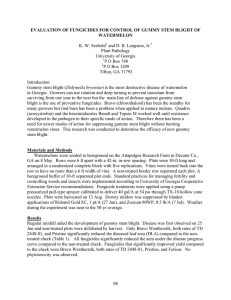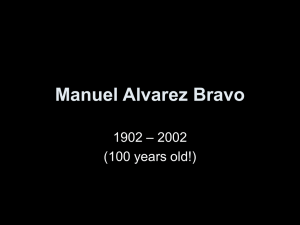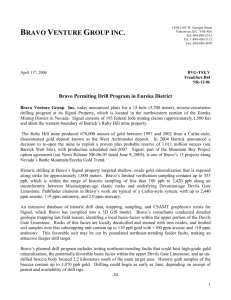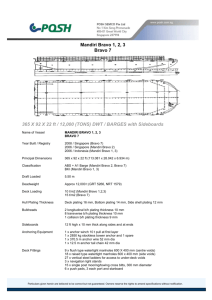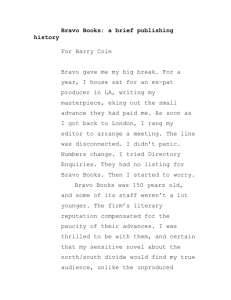K. W. Seebold and D. B. Langston, Jr. Plant Pathology
advertisement
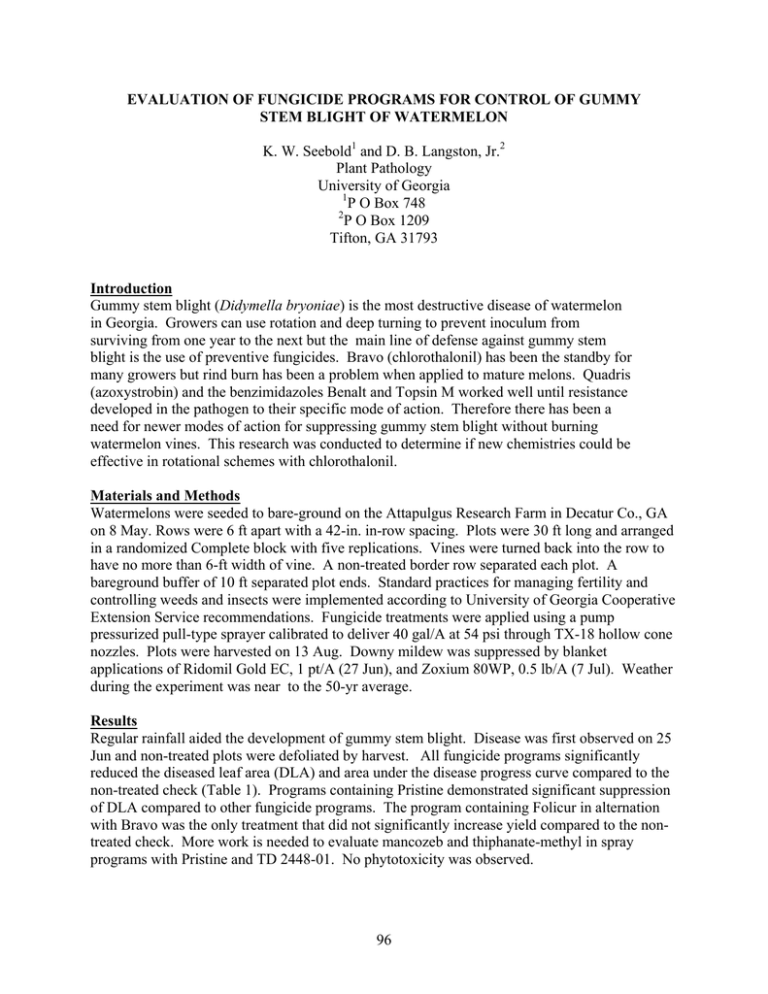
EVALUATION OF FUNGICIDE PROGRAMS FOR CONTROL OF GUMMY STEM BLIGHT OF WATERMELON K. W. Seebold1 and D. B. Langston, Jr.2 Plant Pathology University of Georgia 1 P O Box 748 2 P O Box 1209 Tifton, GA 31793 Introduction Gummy stem blight (Didymella bryoniae) is the most destructive disease of watermelon in Georgia. Growers can use rotation and deep turning to prevent inoculum from surviving from one year to the next but the main line of defense against gummy stem blight is the use of preventive fungicides. Bravo (chlorothalonil) has been the standby for many growers but rind burn has been a problem when applied to mature melons. Quadris (azoxystrobin) and the benzimidazoles Benalt and Topsin M worked well until resistance developed in the pathogen to their specific mode of action. Therefore there has been a need for newer modes of action for suppressing gummy stem blight without burning watermelon vines. This research was conducted to determine if new chemistries could be effective in rotational schemes with chlorothalonil. Materials and Methods Watermelons were seeded to bare-ground on the Attapulgus Research Farm in Decatur Co., GA on 8 May. Rows were 6 ft apart with a 42-in. in-row spacing. Plots were 30 ft long and arranged in a randomized Complete block with five replications. Vines were turned back into the row to have no more than 6-ft width of vine. A non-treated border row separated each plot. A bareground buffer of 10 ft separated plot ends. Standard practices for managing fertility and controlling weeds and insects were implemented according to University of Georgia Cooperative Extension Service recommendations. Fungicide treatments were applied using a pump pressurized pull-type sprayer calibrated to deliver 40 gal/A at 54 psi through TX-18 hollow cone nozzles. Plots were harvested on 13 Aug. Downy mildew was suppressed by blanket applications of Ridomil Gold EC, 1 pt/A (27 Jun), and Zoxium 80WP, 0.5 lb/A (7 Jul). Weather during the experiment was near to the 50-yr average. Results Regular rainfall aided the development of gummy stem blight. Disease was first observed on 25 Jun and non-treated plots were defoliated by harvest. All fungicide programs significantly reduced the diseased leaf area (DLA) and area under the disease progress curve compared to the non-treated check (Table 1). Programs containing Pristine demonstrated significant suppression of DLA compared to other fungicide programs. The program containing Folicur in alternation with Bravo was the only treatment that did not significantly increase yield compared to the nontreated check. More work is needed to evaluate mancozeb and thiphanate-methyl in spray programs with Pristine and TD 2448-01. No phytotoxicity was observed. 96 Table 1. Effect of fungicide programs on severity of gummy stem blight & yield. DLAy 6 Aug Treatment and rate/Az AUDPCx Yield (t)w Bravo WeatherStik 720SC, 2.0 pt (1-6)..........................45.0 cv 2.7 b-d 6.17 a TD 2448-01 3.34SC, 14.6 fl oz (1, 3, 5) Bravo WeatherStik 720SC, 2.0 pt (2, 4, 6) ...............56.0 bc 3.4 bc 5.06 a TD 2448-01 3.34SC, 19.2 fl oz (1, 3, 5) Bravo WeatherStik 720SC, 2.0 pt (2, 4, 6) ...............43.0 c 2.9 b-d 6.99 a Bravo WeatherStik 720SC, 2.0 pt (1, 2, 3) TD 2448-01 3.34SC, 14.6 fl oz (4, 5, 6) ...................36.2 c 2.3 b-d 5.91 a Bravo WeatherStik 720SC, 2.0 pt (1, 2, 3) TD 2448-01 3.34SC, 19.2 fl oz (4, 5, 6) ...................34.4 c 2.5 b-d 6.03 a Pristine 38WG, 10.5 oz (1, 3, 5) Bravo WeatherStik 720SC, 2.0 pt (2, 4, 6) .................9.8 d 1.3 cd 6.63 a Pristine 38WG, 10.5 oz (1, 3, 5) Bravo WeatherStik 720SC, 2.0 pt + Nova 40WP, 4.0 oz (2, 4, 6) ....................................8.8 d 0.9 d 8.06 a Bravo WeatherStik 720SC, 2.0 pt (1, 2, 3) Pristine 38WG, 10.5 oz (4, 5, 6) ...............................10.8 d 1.6 b-d 6.03 a Bravo WeatherStik 720SC, 2.0 pt (1, 3, 5) Folicur 3.6SC, 8.0 fl oz + Induce, 0.06% v/v (2, 4, 6) ....................................68.0 b 3.9 b 4.50 ab Non-treated ...................................................................100.0 a 11.2 a 1.30 b z Spray dates are shown parenthetically and are as follows: 1=25 Jun; 2=1 Jul; 3=9 Jul; 4=16 Jul; 5=24 Jul; 6=30 Jul. y %DLA=percentage of leaf area showing symptoms of gummy stem blight. x AUDPC=area under the disease progress curve, taken from four weekly evaluations beginning on 25 Jun through 6 Aug. w Data represents the total weight of all watermelons per plot on 13 Aug calculated to t/A. v Means in columns with the same letter(s) are not significantly different according to Fisher’s protected LSD test at P≤0.05. 97
